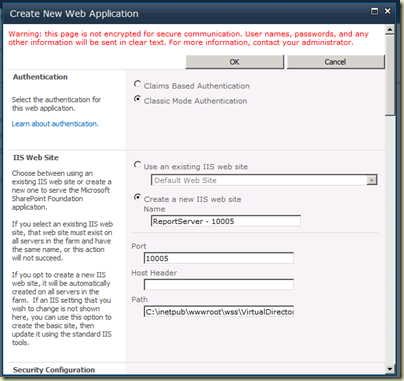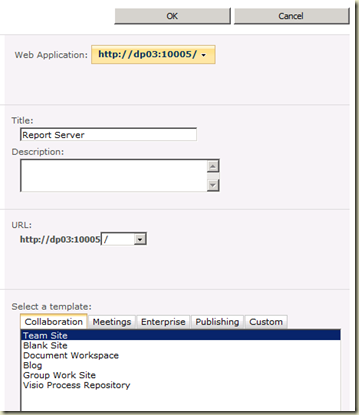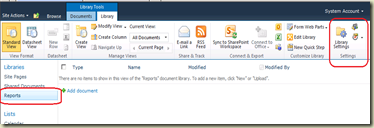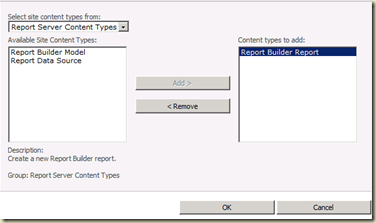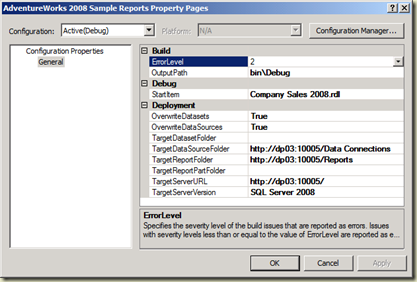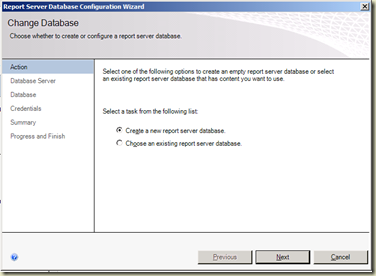Wednesday, July 14, 2010
Configuring Reporting Services 2008 R2 in SharePoint 2010 Integrated Mode – Part II
If you need to create an extremely user-friendly environment for Reporting Services 2008 R2, SharePoint 2010 Integrated Mode is the best solution. Configuring Reporting Services 2008 R2 in SharePoint 2010 Integrated Mode – Part 1 explains the initial configuration up to SharePoint integration. This post discusses creating a web site for Reporting Services with relevant libraries and content types, finally publishing reporting from BIDS.
Let’s start creating a Web Application. Go to SharePoint Central Administration and click Manage Web Applications under Application Management. Once Application Management is open, click on New to create a new web application. 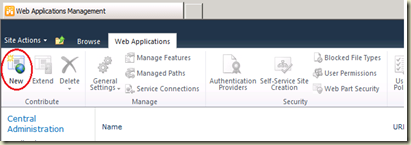
Some of the attributed in New Web Application Form as as follows;
- Authentication
Select Classic Mode Authentication - IIS Web Site settings
Select Create a new IIS web site option. I have named it as Report Server – 10005 and set the port as 10005. - Security Configuration
Leave default values - Public URL
In my case, URL is http://DP03:10005 - Application Pool
Make sure Create new application pool is selected. I have named it as ReportServer – 10005. - Database Name and Authentication
Set the SQL Server name for Database Server. I have named the database as WSS_Content_ReportServer_10005.
Click OK to save setting. Once the process is completed, Application Created windows is appeared. Click OK to continue. New web application will be listed in Web Application window. 
Next step is creating a site collection. Go back to Central Administration and click create site collections under Application Management. This opens Create Site Collection window. Let’s ceate one;
- Make sure that correct web application is selected (In my case, it is http://DP03:10005/.
- Add Title as Report Server.
- Let’s use the root for the Web Site Address. Do not select sites from the drop-down. Leave it blank.
- Select the Template as Team Site.
- Set both Primary Site Collection Administrator and Secondary Site Collection Administrator. Since I have everything in one machine, I set both as DP03\Administrator;.
Once done, a message will be appeared saying Top-Level Site Successfully Created. Click on the link to go the site (In my case, link is http://dp03:10005). This is what I see; 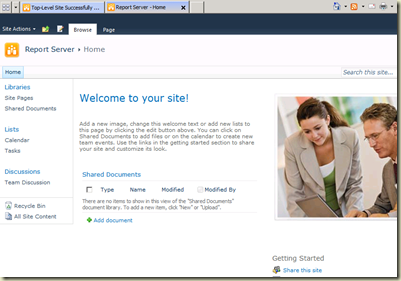
Site needs libraries for holding reports and connections. Let’s create two libraries for the site.
- Click on Libraries link in left pane. It lists all document libraries available.
- Click the button Create for creating a new library.
- When Library Settings is open, library related things such as General Settings, Columns, and Views are shown. By default, it does not show Content Type. In order to enable content type, click Advanced Settings under General Settings. Once the window is open, select Yes for Allow management of content types.
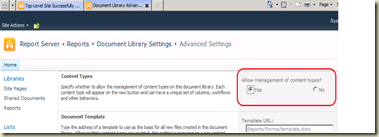
- Click OK to save settings. Note that now the Content Type is shown under Library Settings. Click Add from existing site content types link under Content Type. This opens Add Content Types page.
Now SharePoint 2010 is ready for holding reports from Reporting Services 2008 R2. Let’s try to publish some reports to this. Open Business Intelligence Management Studio and create a Reporting Services project. If you have AdventureWorks 2008 Sample Report Project, you can use it for testing. Once the project is open, get the properties of the project. Set following properties;
- TargetDataSourceFolder: http://dp03:10005/Data Connection
- TargetReportFolder: http://dp03:10005/Reports
- TargetServerURL: http://dp03:10005/
Now deploy reports and see. Reports will be published to SharePoint site we created. Once published, open the home page of the site (http://dp03:10005) and click on Reports link in left pane. It lists all the reports published. 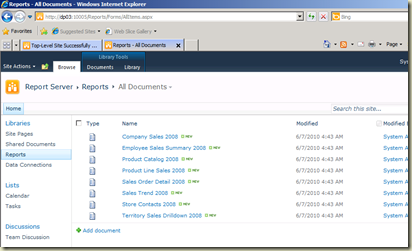
Click one of reports and see whether it works fine. Here is the output of Company Sales 2008 report. 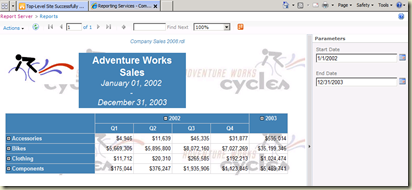
All done. Reporting Services 2008 R2 is integrated with SharePoint 2010. I will be exploring more on this, specially SharePoint related things. Once they are explored, I will publish them.
Integrating Sharepoint 2010 and SQL Reporting Services 2008 in 6 easy steps
Configuring Reporting Services 2008 R2 in SharePoint 2010 Integrated Mode – Part I
Integrating Reporting Services with SharePoint is really a fun and it gives extremely user-friendly environment for Reporting Services. There are mainly two ways of integrating Reporting Services with SharePoint. If Reporting Services is installed in Native Mode, Report Explorer and Report Viewer web parts can be used for interacting with reports. When the Reporting Services is installed in SharePoint Integrated Mode, SharePoint takes overall functionalities of Reporting Services, including SharePoint features such as versioning, alerts, and enterprise search. I recently configured SQL Server 2008 R2 in SharePoint 2010 as Integrated Mode, thought to share the experience; the reason for this post. Note that this is the way I configured the integration, you may take different approach for this integration.
I started this with Windows 2008 R2 and configured SharePoint 2010 on it. See this post “Configuring Windows 2008 R2 for SharePoint 2010” if you come across any issue with the installation. When SQL Server Reporting Services is installed, make sure that you select either “Install the SharePoint integrated mode default configuration” or “Install, but do not configure the report server”.
If you need to complete the SharePoint farm installation using non-domain accounts, this post “Complete Farm SharePoint 2010 installation on Single Server using non-domain accounts” shows you the way.
Once the server is ready with SharePoint 2010 and SQL Server 2008 R2, configuration can be started. If you have selected “Install, but do not configure the report server”, you need to configure Reporting Services in SharePoint 2010 mode. Here are steps for configuring it;
- Open Reporting Services Configuration Manager and connect with Reporting Services instance.
- Make sure that Report Service status is Started. Notice that Report Server Mode is Native.
- Click Next and open the next window of the wizard. Configure the database server which will host the Reporting Services instance. Once authentication is set, click Test Connection and see whether connection can be established successfully. Click Next.
- Type the database name as ReportServer which is the default name. However you can give a names like ReportServerSharePointIntegrated too. Select the option Report Server Mode as SharePoint Integrated. Click Next to continue.
- Set credentials that will be used for connecting to the database. If everything is in one box, Service Credentials would be enough.
- When you click on Next, you will see the summary of what you have entered/selected. Continue with the wizard and complete it.
- If need to change the port of Web Service URL, go to Web Service URL section by clicking Web Service URL navigational tab button and set it. I have set the port as 20000 and my Web Service URL is http://DP03:20000/ReportServer.
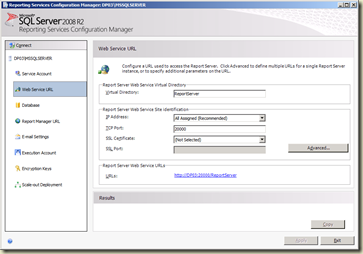
Next step is downloading Reporting Services Add-in for SharePoint 2010. Here is the link for downloading it:http://www.microsoft.com/downloads/details.aspx?displaylang=en&FamilyID=b3bebf9d-d86d-48cd-94e2-0639a846be80.
Once it is downloaded, start installing it. Starting screen would be this; 
Complete the installation. Now all required parts are ready. Next is configuring SharePoint for Reporting Services. Open SharePoint 2010 Central Administration and click on General Application Settings link. 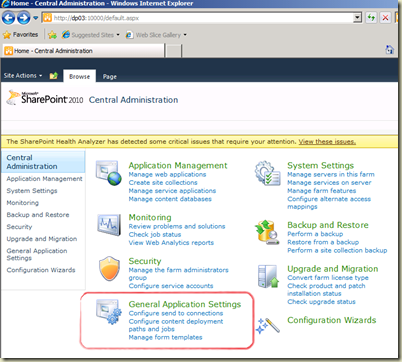
Once the General Application Settings is open, a section called Reporting Services can be seen which allows managing integrating settings. 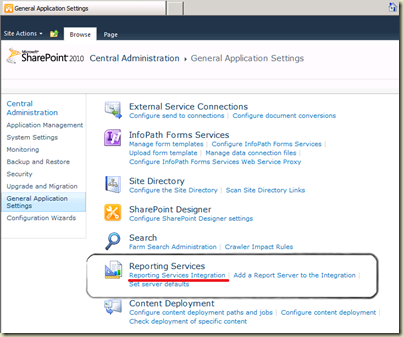
The link Reporting Services Integration opens the window where Report Server Web Service URL and Authentication Mode can be set. The Report Server Web Service URL should be the URL that has been configured with Web Service URL navigational tab of Reporting Services Configuration Manager. Authentication mode can be either Windows Authentication or Trusted Authentication. Since everything is in one box, Windows Authentication would be fine with this.
In order to user Trusted Authentication, a trusted account has to be predefined. When Trusted Authentication is used, Report Server has no knowledge on the user connected to the SharePoint. Trusted account impersonates connected SharePoint user and will be used for accessing the Report Server. Trusted Authentication is usually used with Form Authentication or windows authentication without AD or Kerberos. Here is my screen; 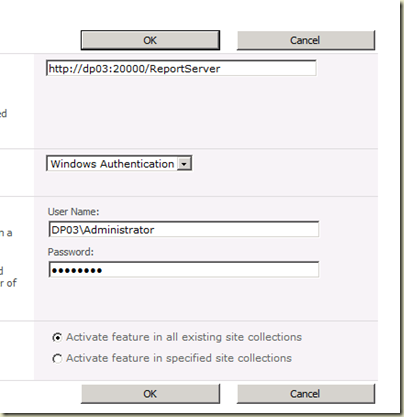 Set Server Defaults under Reporting Services allows changing default server settings for Reporting Services. Some of this elements can be changed are; Number of Snapshots, Ad-Hoc Reporting and Client-Side Printing.
Set Server Defaults under Reporting Services allows changing default server settings for Reporting Services. Some of this elements can be changed are; Number of Snapshots, Ad-Hoc Reporting and Client-Side Printing.
Now the integration is done. The SharePoint is fully integrated with Reporting Services. We need a hosting environment for Reporting Services. Since Reporting Services Add-In has added necessary content types for the Farm, reports can be added to any site. Or else, a new site can be created for hosting Reporting Services reports and connections. See Part II for creating a site, configuring libraries and content type, and publishing reports from BIDS.
Monday, July 12, 2010
Sharepoint Download Zipped List Items !
This Custom UI Actions for Sharepoint extends the lists action menu to allow users to zip document library items and download all of them either with or without version
Features
- Download all document library items
- Keep the folder hierarchy
- Versions: if you are caring about document versions you can download them as well
- Ability to download only the selected view items instead of all list items
The new menu added to the sharepoint document library actions menu
After clicking over the menu item
the compressed file downloaded
the compressed file downloaded with the files versions
Known Issues
- Arabic file names: arabic file names are not downloaded correctly
- The tool uses the system temporary directory to export the list items and compress it, so you need to watch this folder and manage a clean up mechanism












